List of push exercises
It is generally accepted that performing resistance training regularly can help maintain and improve health, fitness, and quality of life. However, people often encounter obstacles to resistance training. These obstacles include time, space, equipment, and cost. Using a TRX suspension trainer can help you overcome these obstacles. These exercises can be performed anywhere and only requires one portable piece of equipment. In addition, suspension training exercises can be used to address a wide range of fitness needs, such as enhancing and maintaining general fitness, improving sports performance, and as a rehabilitation or injury prevention tool.
Using exercises from The Complete Guide to Suspension Training 2E, I’ve put together some of my favorite TRX upper body push exercises. Try out the entire workout or add some of your favorite exercises to your current workout routine.
1.TRX Chest Fly
PURPOSE
To develop the pectoralis major, which is responsible for horizontal adduction of the arms.
ADJUSTMENT
Fully lengthen the straps of the Suspension Trainer.
STARTING POSITION
Stand facing away from the anchor point and grab a handle with each hand. Place the feet hip- to shoulder-width apart. Set the body in a straight line, or plank position.
DESCRIPTION
- Brace the trunk and keep the arms straight.
- Internally rotate the shoulders so the elbows point out to the sides (see figure a).
- Keeping the arms locked in this position, slowly push the hands away from each other while pulling the shoulder blades down and together.
- Attempt to move the hands outward until they are almost directly aligned with the torso, or until a deep stretch is felt in the chest (see figure b).
- In this position, bring the hands back to the starting position.
TEACHING CUES
- When returning to the starting position, act as if wrapping the hands around a tree trunk.
- Maintain a rigid torso throughout the exercise.
VARIATION
Raising one foot off the ground increases the need for greater balance and trunk stability.
Figure A

Figure B
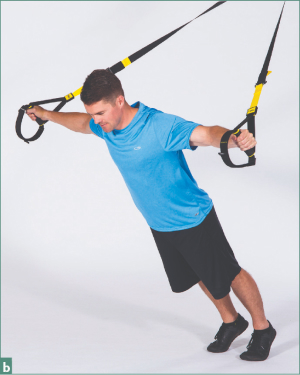
2.TRX Chest Press
PURPOSE
To develop upper-body muscular strength and endurance in the chest, shoulders, and triceps, as well as trunk stability.
ADJUSTMENT
Fully lengthen the straps of the Suspension Trainer.
STARTING POSITION
Stand facing away from the anchor point and grab a handle with each hand. Extend the arms and position the hands shoulder-width apart. Place the feet hip- to shoulder-width apart. Set the body in a straight line, or in plank position.
DESCRIPTION
- Brace the trunk and slowly step backward until there is tension on the straps and the body is at an incline (see figure a).
- Flex the arms and lower the chest between the handles, similar to performing a push-up (see figure b). Extend the arms to return to the starting position.
TEACHING CUES
- Stay stiff as a board from the head to heels.
- Move the handles toward the body in a slow, controlled manner.
VARIATIONS
- In order to place a greater emphasis on strength development, additional resistance can be added to this exercise through the use of a weighted vest.
- To emphasize trunk stability and balance, this exercise can be performed using a single leg for support (see figure c).
Figure A

Figure B
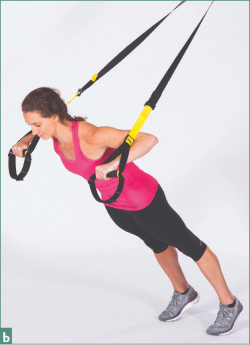
Figure C
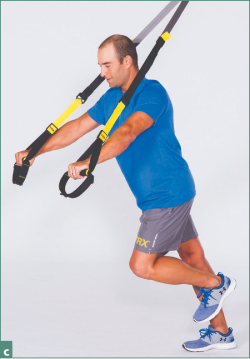
3.TRX Triceps Press
PURPOSE
To isolate and develop the triceps and develop isometric trunk strength and stability. Using the Suspension Trainer results in greater total-body development than using traditional barbell and dumbbell versions of this exercise.
ADJUSTMENT
Fully lengthen the straps of the Suspension Trainer.
STARTING POSITION
Stand facing away from the anchor point. Grab a handle with each hand and lean forward so the torso is at an angle of at least 45 degrees to the ground.
DESCRIPTION
- Extend the arms overhead with the upper arms beside the ears (see figure a).
- Flex the elbows to 90 degrees. At this point, the hands should be behind the head with a neutral grip (see figure b).
- While keeping the balls of the feet in contact with the ground and the trunk rigid, extend the elbows to return to the starting position.
TEACHING CUES
- Maintain a rigid torso throughout the exercise.
- Move only at the elbows.
VARIATIONS
- External resistance in the form of a weighted vest can be added to this exercise to increase the intensity.
- This exercise can also be modified by grabbing the handle straps with one hand, assuming a staggered stance, and applying manual resistance throughout the exercise movement.
Figure A
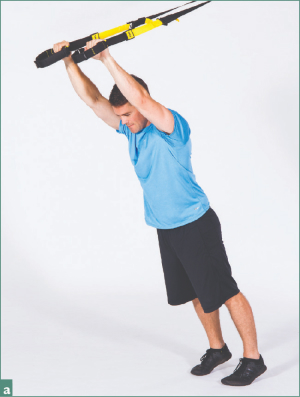
Figure B
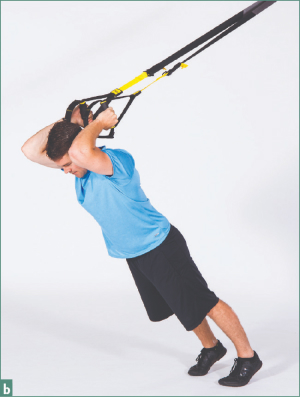
4.TRX Pause Push-Up
PURPOSE
To develop muscular size, strength, and endurance of the chest, shoulders, and triceps.
ADJUSTMENT
Adjust the straps of the Suspension Trainer to mid-calf length.
STARTING POSITION
Lie on the ground facing away from the anchor point and place the feet in the foot cradles. Place the hands on the ground slightly wider than shoulder-width apart (see figure a). Set the body in a straight line, or plank position.
DESCRIPTION
- Flex at the elbows to lower the body to the ground until the upper arms are parallel to the ground and hold this position for approximately three to four seconds (see figure b).
- Extend the arms and push the body back to the starting position.
- Repeat for the desired number of repetitions.
TEACHING CUES
- Maintain a plank position.
- Stay stiff as a board from the head to heels.
- Push the ground away.
Figure A
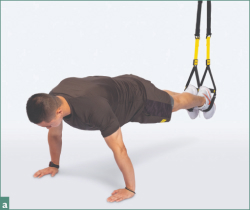
Figure B
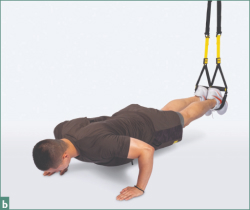
Credit: Adapted from Complete Guide to TRX Suspension Training 2E. Available for purchase at Human Kinetics - Canada